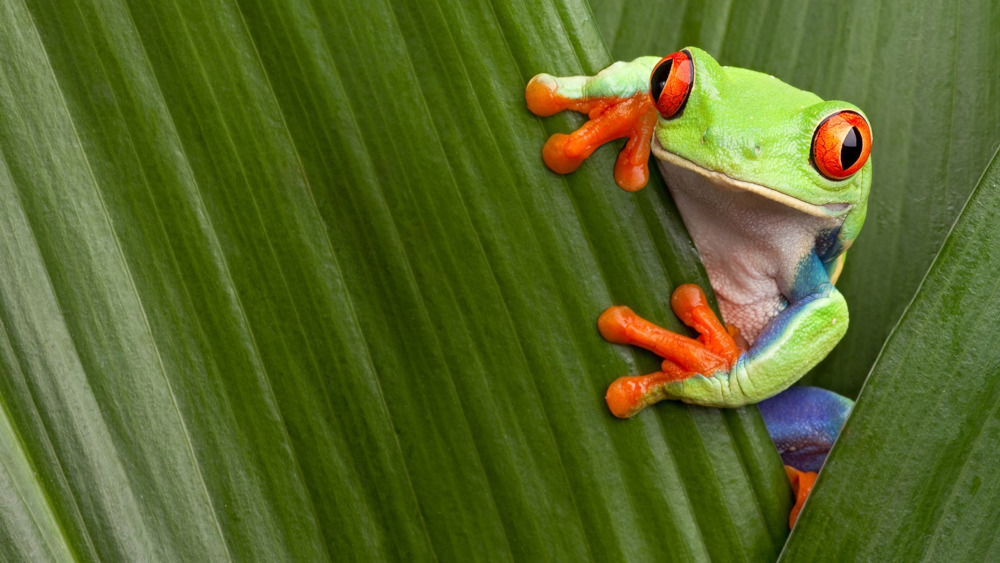The red-eyed tree frog (*Agalychnis callidryas*) is one of nature’s most striking and captivating amphibians. Known for its vivid red eyes, vibrant green body, and colorful blue and yellow flanks, this nocturnal arboreal frog has fascinated scientists and nature enthusiasts alike. Native to the rainforests of Central America, the red-eyed tree frog’s unique adaptations, behaviors, and ecological significance make it a subject of great interest in the study of tropical biodiversity.
Physical Characteristics
The most distinctive feature of the red-eyed tree frog is, unsurprisingly, its large, bright red eyes. These eyes are not just for show; they serve a crucial role in the frog’s survival. The vibrant red coloration is thought to startle potential predators, a phenomenon known as “startle coloration.” When the frog is at rest, its eyes are partially closed, blending into the surroundings. However, when disturbed, the sudden exposure of its red eyes can confuse and deter predators, giving the frog a precious moment to escape.
The frog’s body is predominantly a bright green, which provides excellent camouflage among the leaves and foliage of its rainforest habitat. This green color is complemented by blue and yellow stripes along its sides and limbs, and orange or red feet. The undersides of the feet are equipped with adhesive pads, allowing the frog to cling to and climb vegetation with ease.
Habitat and Distribution
The red-eyed tree frog inhabits the tropical lowland rainforests from southern Mexico through Central America, extending as far south as Colombia. These frogs prefer areas near rivers, ponds, and lakes where humidity is high, and vegetation is abundant. They primarily live in the canopy, descending to the forest floor mainly during the breeding season.
Behavior and Diet
As a nocturnal species, the red-eyed tree frog is most active at night, when it hunts for food and engages in mating activities. Its diet consists mainly of insects, including crickets, moths, and flies. Occasionally, it may also consume smaller frogs or other small invertebrates. Its hunting strategy relies on its excellent night vision and the ability to remain still for extended periods before pouncing on unsuspecting prey.
During the day, the red-eyed tree frog remains motionless, with its limbs tucked in and its eyes closed to avoid detection by predators. This behavior, combined with its green coloration, makes it almost invisible against the backdrop of leaves.

Reproduction and Life Cycle
The breeding season for red-eyed tree frogs typically coincides with the rainy season, which varies depending on the geographical location. Males attract females with a distinctive croaking call, and once a female likes them, the male climbs onto her back in a position popular as amplexus. This position allows the male to fertilize the eggs as the female lays them.
Females lay their eggs on the undersides of leaves that hang over water bodies. This strategic placement ensures that, upon hatching, the tadpoles drop directly into the water below, where they continue their development. The eggs are gelatinous and are vulnerable to predation by insects and other small animals. To mitigate this risk, some studies suggest that the eggs can hatch prematurely if they sense vibrations caused by a predator, allowing the tadpoles to drop into the water and escape.
Tadpoles undergo a metamorphosis over several weeks, transforming from aquatic larvae into fully developed frogs capable of climbing and living on land. This transformation includes the development of limbs, the absorption of the tail, and changes in the respiratory and digestive systems.
Ecological Significance
Red-eyed tree frogs play a crucial role in their ecosystem. As both predators and prey, they are integral to the food web. They help control insect populations, and in turn, they provide sustenance for a variety of predators, including birds, snakes, and mammals.
Their presence also indicates the health of their habitat. Amphibians are bioindicators because their permeable skin makes them highly sensitive to environmental changes, such as pollution and climate change. A healthy population of red-eyed tree frogs suggests a well-balanced and thriving ecosystem.
Conservation Status
The red-eyed tree frog is in “Least Concern” by the International Union for Conservation of Nature (IUCN). However, like many amphibian species, it faces threats from habitat destruction, climate change, and disease, particularly chytridiomycosis, a fungal infection that has decimated amphibian populations worldwide.
Efforts to conserve the red-eyed tree frog include protecting its natural habitat through the establishment of national parks and reserves, as well as initiatives to mitigate climate change and pollution. Captive breeding programs also play a role in ensuring the survival of this species, providing opportunities for research and reintroduction into the wild if necessary.
Conclusion
The red-eyed tree frog is more than just a symbol of the rainforest; it is a testament to the intricate and delicate balance of nature. Its vivid appearance, unique behaviors, and ecological role make it a subject of fascination and importance in the study of biodiversity. By understanding and protecting the red-eyed tree frog, we gain insight into the health of our planet’s ecosystems and the steps needed to preserve them for future generations.









